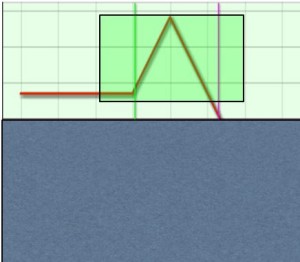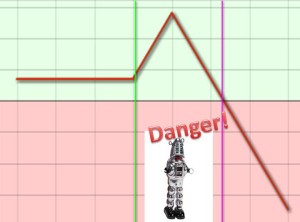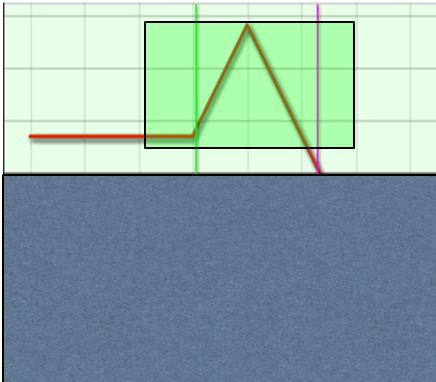Today’s Post: 1150 gluten-free low calorie words… Plus lots of pictures 🙂 . Take ya four minutes to read.
But WHY? Easy …because YOU want to know how to do a riskless spread trade… that can pay you twice.
From RadioActive Trading: The “Money Net” Play
Hey there Traders!
Today I’ll be sharing with you how my buddy Mike Chupka of PowerOptions was able to open a play at a $0.40 credit… CLOSE it a few short weeks later for a SECOND, much higher credit… and do this special form of spread trade without risking a dime.

“Secret” Technique to Eliminate Risk from a Ratio Call Spread… a Spread Trade that Can Pay You TWICE!
Not shab-bay. 😉
First, before you hang up the phone (wait, does this site even do mobile?) I’d like to show you how Mike got the first and second payout. THEN I’ll show you how it was indeed done with zero risk.
Shall we?
The Ratio Call Spread: Get Paid TWICE for One Position
On April 21st this year, Avis Budget Rental Group (CAR) was trading around $53 a share. Mike saw that he could get a net credit of .40 cents for buying one, then selling TWO calls with a May expiration.
Let’s go to the drawing board…
Now, normally taking a .40 cent premium on any credit spread (e.g. Bull Put Spread, Bear Call Spread) means a high probability of being able to keep the premium. BUT..! There’s still a pesky chance (normally) that the spread may BACKFIRE on you and end up costing you money in the end.
In a moment I’ll show you why Mike had NO reason to fear this. Doing this spread, or any spread trade normally involves capital risk… but the way this play was structured there was no way Mike was gonna lose anything as a result of this play.
I’ll get to that. FIRST, let’s see how Mike was able to get paid twice for one credit spread:
On Expiration Friday in May, CAR is Trading Around $54.90 During the Day…
Again, not shabby at all. Mike was paid .40 on the front end, then 2.05 later when he closed the trade here on Expiration Friday.
81.48% MORE Premium Than a Covered Call!
No dip. Sounds too good to be true… so I guess it makes sense to show the black-and-white numbers on that. 81% higher premium is nothing to sneeze at, IF it’s true.
So let’s see. On April 21st above, Mike did the “Money Net”, or Ratio Call Spread play by buying one, selling TWO calls at a .40 credit. He later closed it for a second $2.05 credit by buying to close the short calls and cashing in his long call. Net Credit: $2.45
If Mike had only sold a covered call, that would be $1.50 credit on the front end, minus .15 cents later to keep the stock. That’s $1.35.
$2.45 is 81.48% higher premium than $1.35.
Woo hooo!
So now you see how Mike was able to get paid TWICE for one play, and get paid quite handsomely. Great job Mike!
Nice. But Is This Really a RISKLESS Spread Trade?
Yes.
As promised, now I’ll also show how Mike was able to do the Ratio Call Spread WITHOUT the worry that normally goes with it.
Normally, by selling two calls and buying one, we create a situation that looks like this:
The (Normally) Treacherous Ratio Call Spread Risk/Reward Graph

The Ratio Call Spread Normally Carries INFINITE Upside Risk. Fortunately, There Is a Way to Eliminate ALL the Risk
The reason for that unlimited risk to the upside is that one of those short calls is “naked”, or uncovered by stock.
If the stock goes up a lot, we have an obligation to deliver shares at $55, but may have to buy them at a much higher price (wait… didn’t that one guy tip me to buy low, sell high?) Hmmm…
At first blush, the Ratio Call Spread play looks like the riskiest of propositions.
Sure, having a “naked” call is risky. But what if this play was done in the context of owning the underlying stock?
Then for all intents and purposes we wouldn’t have a Ratio Call Spread anymore; it would be more like a Bull Call Spread (one long call at the $52.50, one short call at the $55 strike), accompanied by a Covered Call at the $55 strike.
Oh, and all done at a credit.
THEN what is the upside risk for the Ratio Call Spread?
When you own the stock, it’s…

When You Do a Ratio Call Spread on a Stock That You Already Own at a Low Cost Basis… NO Capital Risk is Introduced But You DO Take a Credit
Zilch, zero, nix.
Nada thing.
Because when you have the stock on hand to deliver, you needn’t go out on the open market and buy shares high, just to sell ’em low.
So you can see that doing the Ratio Call Spread (or as I like to call it, “Money Net”) adds no capital risk to Mike’s account:
- He gets paid .40 cents for putting it in place;
- He may get paid again if his underlying stock closes in a wide range;
- He cannot get hurt by the normal consequences if his stock goes up!
Wait! …It Gets (Even) Better
Not only did Mike’s play here net him a tasty double-dip of premium… it also put him in position to BULLETPROOF his stock.
Because I know what you are thinking: “Sure, doing the Ratio Call Spread in the context of owning the stock introduced zero capital risk. But owning the stock in the first place sure had some risk to it!
Heh… s’okay.
Because Mike had in place another play that limited his risk down to 6.7%, NO MATTER WHAT HAPPENED to his stock. That’s better than the stop orders some people use.
Plus, AFTER collecting the total of $2.45 premium from the Ratio Call Spread play detailed in this post… Mike ended up with even less risk.
Mike still happens to own CAR. But by using the RadioActive Trading Income Methods he has now erased all his risk of ownership, clear out to January of 2015. We call this phenomenon Bulletproofing.
…but that’s a topic for another post.
Who Else Wants to Learn to Do Riskless Spread Trades?
Hey there, Good Lookin’! You just read how to do one type of Riskless Spread trade…but here at RadioActive Trading there are many more ways to apply riskless spread trades in the proper context!
In our Stop Losing at Credit Spreads Forever video, you will see SEVEN killer techniques for taking income from the market beginning with super-low risk (for the structure), NO risk for the spread plays, and ending with ZERO risk for either.
If you’re sick and tired of losing the spread trading game, taking small wins 80% of the time but then giving back all your profits in one silly miscalculation or sudden move against, and you’d rather see your earnings compound and grow and if you are ever wrong… THAT’S COMPLETELY POSSIBLE if you use the content of this VIDEO and you have structured yourself wisely with this no capital loss plan.
CLICK HERE to pick up your copy of Stop Losing at Credit Spreads Forever!
Can you think of another Trader that might enjoy this article? Did you get an interesting enough thought out of it that you’d like to make sure not to miss any others? Share or Subscribe now.
Also, I’d LOVE to hear your thoughts about this riskless Ratio Call Spread of Mike’s, so post ’em in the comments!
Til then, Happy Trading,
Kurt




 I'm Kurt Frankenberg, and I have discovered how to truly put the odds on the side on the individual investor.
I'm Kurt Frankenberg, and I have discovered how to truly put the odds on the side on the individual investor.
What’s the other play he had to limit the downside risk to less than the 6.7%?
Thanks,
John
Hiya, John! Mike’s other play is that he had a married put in place. Owning stock plus owning a put “put” only 6.7% of his capital AT RISK. Then, using the ratio call spread he captured .40 cents…. reducing the risk in his married put play…. then $2.05 more, reducing his risk even further.
Since then Mike has employed other “Income Methods” to further reduce his risk in that married put play. He is currently “Bulletproof”… meaning that the cost basis of what he hasa effectively spent for stock and put option is LESS than the strike price of the put. He currently has a January $57.50 put, plus stock and his cost basis is under $57.50 so he can win, but cannot lose.
Meanwhile, Mike is able to do OTHER “nested spread trades” like the one detailed in this article to grab premium, without risking any capital.
Kinda cool.
Happy Trading,
Kurt
I think this article is a bit misleading. Actually this is not a ratio call spread, it is rather a combination of a covered call with a bull call spread. Neat but not really kosher. Do you have any unconventional spreads that do not oblige one to buy stock?
Hiya, Chris. No, it’s not a bit misleading… I’m sharing the fact that a ratio call spread may be performed risklessly, in the same sense that selling a call option may be performed risklessly if done in the context of owning the stock.
A “naked” call has infinite capital risk. A “covered” call has no risk… that is, shorting the call itself adds no capital risk, where it normally would introduce UNLIMITED risk if stock were not owned.
Now, is there risk to owning the stock? Of course there is. That’s why Mike did this play in the context of a married put. That took care of all but 6.7% of the downside; that is, if CAR had gone down by 10%, 20%, even 50% or more… all that Mike could possibly lose by owning the stock would be 6.7%.
Doing the ratio call spread IN CONTEXT of owning the stock added no capital risk to the upside. Furthermore, after this play was closed for a double-dip profit, the cost basis of Mike’s stock was reduced from $49.45 to $47.00, and his put protects him clear out to January 2015.
NOW, Mike has bulletproofed his stock + put combination, by using this ratio call spread and other RadioActive Trading Income Methods to further reduce his cost basis for the stock, while retaining a long term put.
If Mike wants to do another ratio call spread, HE MAY without any fear of losing capital because he has the stock on hand… and if his stock goes down, he can no longer be hurt by that either.
Again, kinda cool.
Thanks for the input. As far as your point… it’s like a bull call spread accompanied by a covered call… you’re right. But what do we call that? Simply adding a short call makes it a collar (’cause he owns a put option also) but what are we gonna say about the new, somewhat complex position? I prefer to call it what it is… a ratio call spread… done IN CONTEXT of another trade.
A trade that itself is also now riskless. Mike’s married put can’t bite him, even gently to the tune of 6.7% any more. He is Bulletproof and can continue doing nested ratio call spreads or any other RadioActive Trading technique to milk this sucker for more premium.
Yowza.
Happy Trading,
Kurt
hi kurt im new to this but if he is obligated to deliver the stock at 57.50 then buy the stock back at 60 doesn’t this change his overall position in his account . is he selling the one call he bought at 60 or is he selling the stock then buying it back?
Risk free?
There is no mention of if the stock falls PAST the premium gained by the net of two naked calls – one long call. After that, this trade is suicide if the stock falls. And, in this market, this is truly a suicide trade.
And, if you say “well, we added a put for protection”, then that put eats away/eliminates any net you had with the net gain from the shorted calls.
Come on now. Find us a truly risk free trade that makes money…
Marc
I assume you didn’t get a reply because you weren’t capable of understanding the play. He had a bull call spread and a covered call as well as a put, it was risk free as I have personally done this exact play many times myself.
It is always a disappointment to see that the follow-up posts to the OP that are wrong-headed are quickly answered and refuted, but when a post that shows there is a possible real hole in the OP’s approach, the post simply goes conveniently unanswered. Johnyoga has a valid point, but no follow up. This causes a loss of credibility to the OP.
There is no reason not to admit that, yes, there is that possibility of a downside fast move that would wipe out the premiums collected and put the whole plan into a loss position. Just be honest about the whole risk picture and people will be better equipped to deal with it. Leaving out critical pieces simply makes the OP look like a salesman instead of a trusted guru.
Boom. Got’em ^
This guy’s a hack. You’ll rack up tons of commissions and per-contract fees employing this trade, as you’ll need to leverage up on number of contracts bought/ written to make any meaningful profit.
GFYourself,
You’ll pay commish and per-contract fees employing any strategy. What is the point you’re trying to make? Dunno about “hack”… so far folks in 44 countries have bought my books and I have drawerfuls of testimonials and thank-you letters. Show me yours maybe? 🙂
Happy Trading,
Kurt
Sell a next month naked put way otm for up front premium. If SPY drops to within 200 points, buy back and roll out to the next month to get back “lost” capital. Can also do 2 months ahead. Best to buy big on dips (Daily Chart) carefully on Monthly highs. Oh that’s European Options !
Kurt,
I like you, and I want to buy whatever your selling. Just shoot me the link. These methods are great.
Hi Kurt. I love your stuff. did married put strategy with positive effect. can’t afford blueprint yet but I do enjoy your webinars. I am kinda an options newbie but i would love to learn from you ALL you know abt options and bulletproofing.
Well to learn all I know you will want to pick up The Blueprint. BUT..! Keep coming to the free webinars and I’m sure you will find the most important things I share there without charge.
Hi Kurt, this is jnsegal.(aka: meziggy..the one at your webinar two weeks ago and who asked abt the tats on your your forearm) well anyway, hope you, and Sabrina, and the German Shepherd Jovi, and his ninja cat Tabi are well. I am hoping you can help me out. In 12/2015 I did your Married Put Strategy where I bought MSFT (the stock) @ $55.47 and also BTO 07 2016 put
K= $65.00. I simultaneously STO 07 2016 65k call and pocketed the credit. In 01-2016 I STC the 07 2016 put for a profit and then in 02-2016 i BTC the 65K call also for a small profit. Since then I changed brokers to OptionsHouse. I decided today to BTO a 01-17 $57.00 K put for $7.00 and then STO a July 16 call $50.00 K for $1.64 credit and it gets rejected by my broker saying “my accounts net liquidation value is less than the requirement. contact customer service”. I contact them and they tell me I need a level 6 and I only have a level 3 and not enough in my account for this transaction. I have about $1500.00 in the the account. Does that sound correct to you? why was I able to do the exact same thing earlier with TradeKing but get rejected by OptionsHouse? I know you can’t answer for them, but do these transactions sound correct that i attempted to do and should I go back to complain to OptionsHouse?
Your response and direction will be greatly appreciated.
Thank you in advance,
jnsegal(aka: meziggy) and at meziggy@juno.com
@jnsegal, having worked at a brokerage myself, it sounds like your strategy of simply buying a Put and selling a Call is not really a strategy, i.e. the Call option is naked, which requires the highest level of options trading permissions. I’m not sure what their margin requirement is on a naked Call. Hope this helps
Thanks for your assistance. 🙂
jnsegal
Wouldn’t buying a protective call provide the same insurance as buying the stock at a MUCH lower cost?
That depends Larry!
Elsewhere in this blog I’ve drawn attention to the importance to position sizing. In the example today, where 100 shares are balanced by a put, the position size as more or less “automated”.
Now. If the amount of capital you have to trade is $6150, the example with 100 shares of SBUX plus a 2017 $60 put and a total cost of $6150 works pretty well. If by 9/5 the stock goes down 10%, from $55.90 to $50.31, the $1.31 loss will be 2% of available capital. 2% loss is quick and easy to recover from.
Let’s compare that “equivalent” trade of a long call being done with a fella using $500 account. A long Jan 2017 $60 call would have been available on 8/5 at $1.50 If by 9/5 the stock has gone down 10% from $55.90 to $50.31… not we’re looking at that call being worth .37 cents.
The percent less of one’s capital to trade is $131 of $500, or 26.2%. Recovering from that kind of loss is a marathon.
So the question becomes not “wouldn’t be call be the same”… but rather “WHY would you prefer to trade a call than stock plus a put IF a greater amount of capital was available?”
Whether you use your $6150 to trade one $150 and put the $6000 in an interest-bearing account, or use the whole $6150 in the stock-plus-put play, it’s now the exact risk/reward profile. Aaaaand… the laws of the land (regarding taxation and margin) and the rules of your broker (regarding what kinds adjustments they will allow) permit a lot more flexibility regarding the “Income Methods” of Radioactive Trading.
But that’s a topic for another post.
Thanks for the Q, Larry! In short, “MUCH lower costs” means much more proportional risk according to the Martingale. Better to automate the process of limiting risk to your capital and stand aside the trades you can’t “afford” to put on.
Happy Trading,
Kurt
[…] The Riskless Spread Trade that Pays You TWICE […]
[…] The Riskless Spread Trade that Pays You TWICE […]